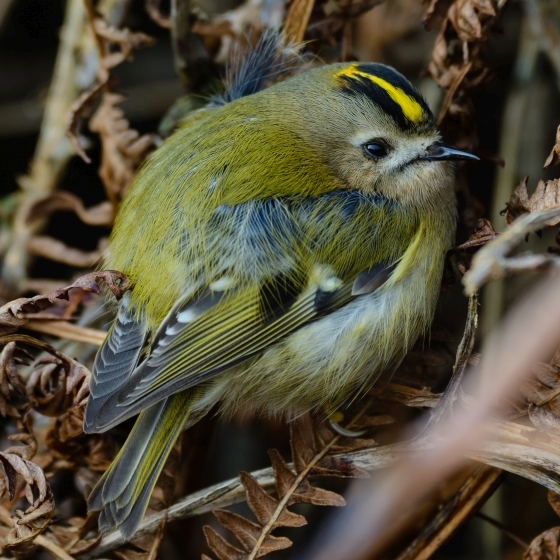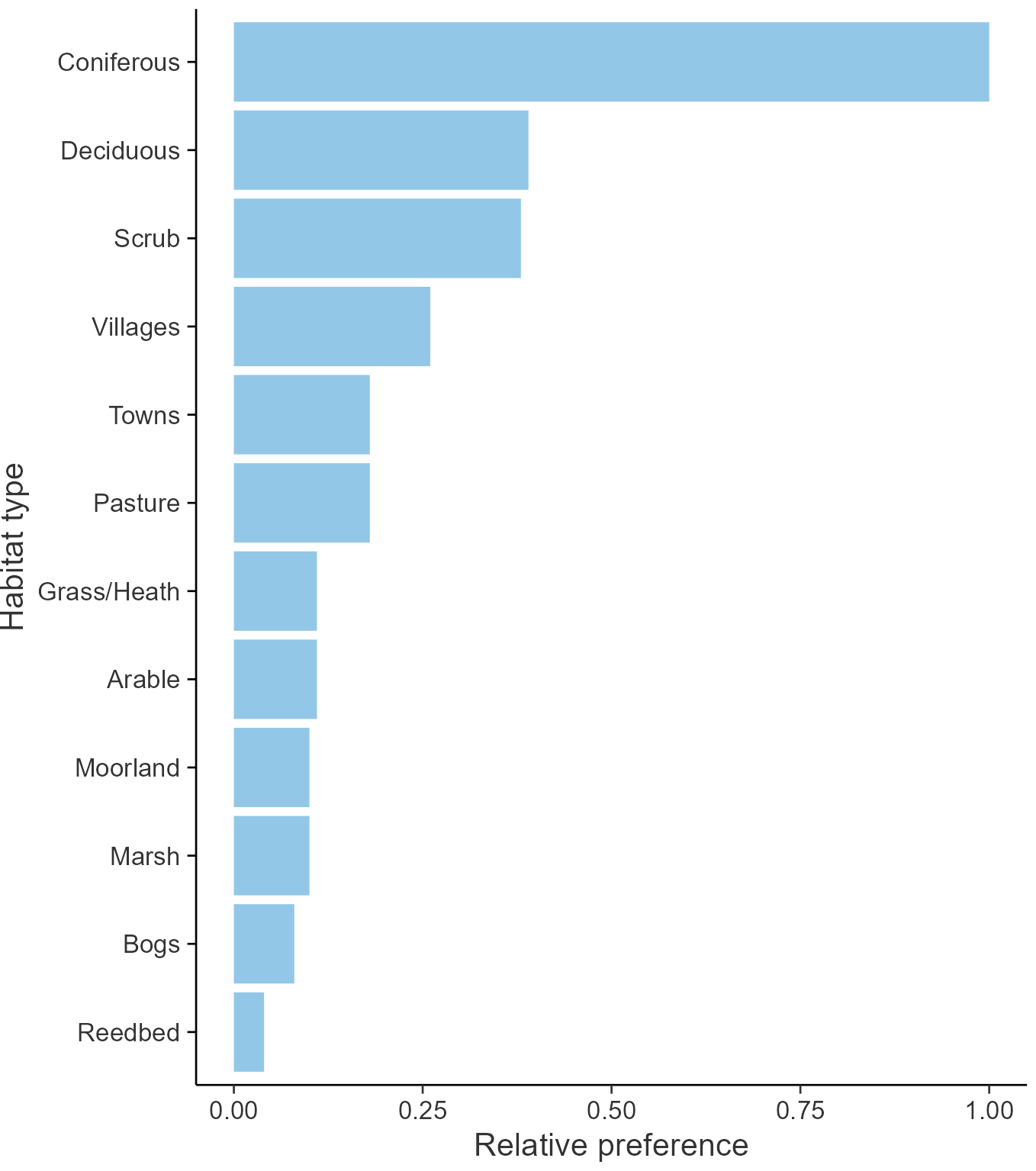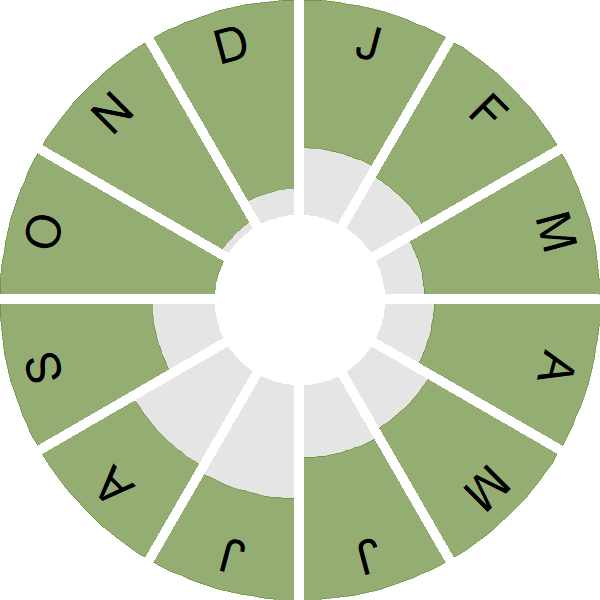Goldcrest

Introduction
Widely distributed throughout Britain & Ireland, this tiny songbird vies with the closely-related Firecrest for the title of our smallest breeding bird.
Being so small (5-6 g), Goldcrests are vulnerable in cold weather, and as such numbers fluctuate depending on the harshness of the seasons. In winter, the resident Goldcrest population is bolstered by arrivals from Fennoscandia, and impressive numbers can sometimes be found on the east coast in the autumn, recovering in the dunes after their long flight across the North Sea.
Despite their small size, female Goldcrests can lay up to 12 eggs in a clutch (one and a half times an adult's bodyweight). Goldcrests have an overall olive appearance, with their eponymous stripe on the top of their heads, which is more orange in males and yellow in females. Goldcrests can often be seen searching trees, especially conifers, for small invertebrate prey. Their high-pitched, repetitive song can also be a good way to find one.
- Our Trends Explorer gives you the latest insight into how this species' population is changing.

Key Stats
Identification
ID Videos
This section features BTO training videos headlining this species, or featuring it as a potential confusion species.
Goldcrest & Firecrest
#BirdSongBasics: Goldcrest and Treecreeper
Songs and Calls
Song:
Call:
Begging call:
Status and Trends
Conservation Status
Population Change
Goldcrest abundance is affected unusually severely by winter weather, and the strong increase in the species' CBC/BBS index up to the mid 1970s can be interpreted as recovery from the cold winters of the early 1960s. The subsequent decline temporarily moved the species to the amber list, but its status has now been restored to green. The long-term trend looks very much like a series of damped oscillations following recovery from the 1962/63 winter. BBS has recorded some initial increase in all UK countries, followed by a long decline that ended around 2010, although a further decline has occurred in Wales since 2015 and the overall decline in Wales from 1995-2018 is of sufficient magnitude to trigger a higher level alert. The BBS map of change in relative density between 1994-96 and 2007-09 indicates that decrease occurred over that period in southwestern England, Wales and Caithness but that increases occurred elsewhere, especially in Northern Ireland and western Scotland. There has been a decline across Europe since 1980 (PECBMS: PECBMS 2020a>).
Distribution
Winter and breeding-season distributions of the Goldcrest are similar with birds found in 90% of 10-km squares in winter and 88% of squares in the breeding season. The main gaps in distribution occur in the treeless landscapes of the Scottish Highlands, Outer Hebrides, Northern Isles and the Fens in England. The highest densities in both seasons are found in Ireland.
Occupied 10-km squares in UK
or view it on Bird Atlas Mapstore.
or view it on Bird Atlas Mapstore.
European Distribution Map
Distribution Change
Modest gains in the number of occupied 10-km squares have been recorded in both winter and the breeding season.
Change in occupied 10-km squares in the UK
or view it on Bird Atlas Mapstore.
or view it on Bird Atlas Mapstore.
Seasonality
Goldcrest is recorded year-round on around 15% of complete lists, increasing to almost 30% in autumn when there is a large arrival of birds from the continent.
Weekly pattern of occurrence
The graph shows when the species is present in the UK, with taller bars indicating a higher likelihood of encountering the species in appropriate regions and habitats.

Habitats
Breeding season habitats
Relative frequency by habitat
The graph shows the habitats occupied in the breeding season, with the most utilised habitats shown at the top. Bars of similar size indicate the species is equally likely to be recorded in those habitats.

Movement
Britain & Ireland movement
Foreign locations of birds ringed or recovered in Britain & Ireland
Dots show the foreign destinations of birds ringed in Britain & Ireland, and the origins of birds ringed overseas that were subsequently recaptured, resighted or found dead in Britain & Ireland. Dot colours indicate the time of year that the species was present at the location.
- Winter (Nov-Feb)
- Spring (Mar-Apr)
- Summer (May-Jul)
- Autumn (Aug-Oct)

European movements
EuroBirdPortal uses birdwatcher's records, such as those logged in BirdTrack to map the flows of birds as they arrive and depart Europe. See maps for this species here.
The Eurasian-African Migration Atlas shows movements of individual birds ringed or recovered in Europe. See maps for this species here.
Biology
Productivity and Nesting
Nesting timing
Egg measurements
Clutch Size
Incubation
Fledging
Survival and Longevity
Survival is shown as the proportion of birds surviving from one year to the next and is derived from bird ringing data. It can also be used to estimate how long birds typically live.
View number ringed each year in the Online Ringing Report.
lifespan
Survival of adults
Biometrics
Wing length and body weights are from live birds (source).
Wing length
Body weight
Ring Size
Classification, names and codes
Classification and Codes
- Order: Passeriformes
- Family: Regulidae
- Scientific name: Regulus regulus
- Authority: Linnaeus, 1758
- BTO 2-letter code: GC
- BTO 5-letter code: GOLDC
- Euring code number: 13140
Alternate species names
- Catalan: reietó eurasiàtic
- Czech: králícek obecný
- Danish: Fuglekonge
- Dutch: Goudhaan
- Estonian: pöialpoiss
- Finnish: hippiäinen
- French: Roitelet huppé
- Gaelic: Crìonag-bhuidhe
- German: Wintergoldhähnchen
- Hungarian: sárgafeju királyka
- Icelandic: Glókollur
- Irish: Cíorbhuí
- Italian: Regolo
- Latvian: zeltgalvitis
- Lithuanian: paprastasis nykštukas
- Norwegian: Fuglekonge
- Polish: mysikrólik (zwyczajny)
- Portuguese: estrelinha-de-poupa
- Slovak: králik zlatohlavý
- Slovenian: rumenoglavi kraljicek
- Spanish: Reyezuelo sencillo
- Swedish: kungsfågel
- Welsh: Dryw Eurben
Research
Causes of Change and Solutions
Causes of change
Severe weather is likely to have caused wide short-term variability in abundance, but there is little good evidence available regarding the drivers of the longer-term breeding population change in this species in the UK, although
Further information on causes of change
The high amplitude of year-to-year change reflects the species' high breeding potential, and its sensitivity to cold winter weather. Modelling suggests that climate change may have had a positive impact on the long-term trend for this species (Pearce-Higgins & Crick 2019). CBC had relatively poor coverage of conifer plantations, in which Goldcrests occur at increasing densities as the trees mature. A general increase in the area of prime habitat has therefore been poorly reflected in the long-term trend.
Information about conservation actions
Annual changes in Goldcrest abundance are probably driven mainly by winter weather and hence specific conservation options for this species may be limited. Numbers may increase in the future due to warming from climate change, although this is uncertain as the effects of climate change could include increased frequency of severe weather events.
Publications (1)
Birds of Conservation Concern Wales 4: the population status of birds in Wales
Author: Johnstone, I.G., Hughes, J., Balmer, D.E., Brenchley, A., Facey, R.J., Lindley, P.J., Noble, D.G. & Taylor, R.C.
Published: 2022
The latest review of the conservation status of birds in Wales. The report assessed all 220 bird species which regularly occur in Wales. There are now 60 species of bird on the Red List, with 91 on the Amber List and just 69 - less than a third of the total number of species - on the Green List.
06.12.22
Reports Birds of Conservation Concern


